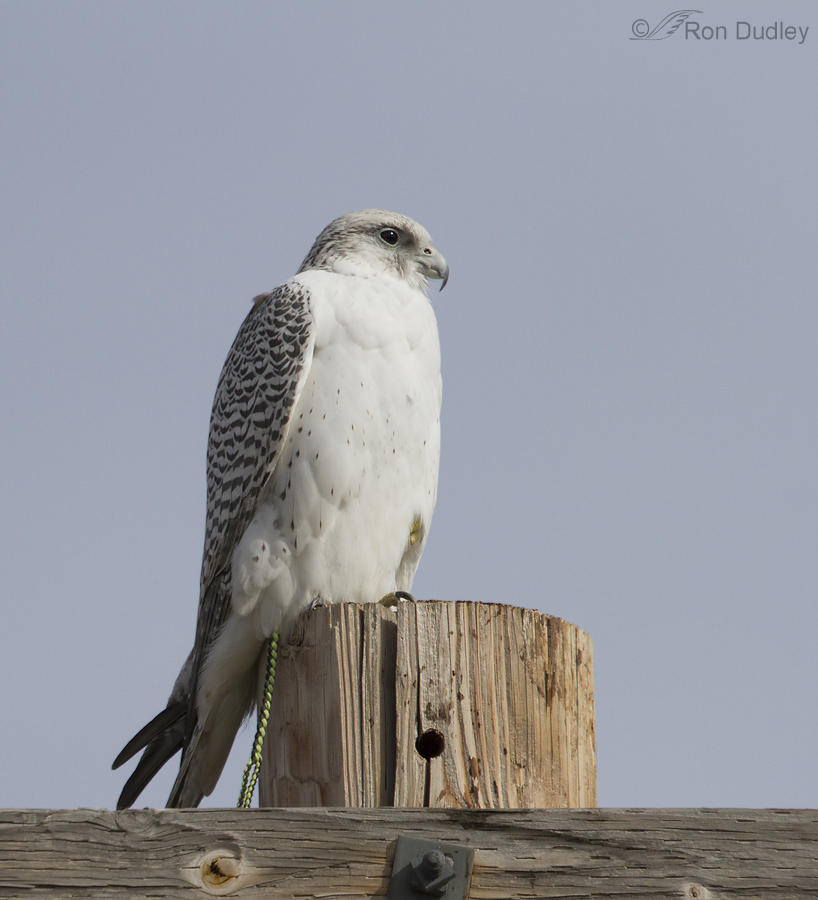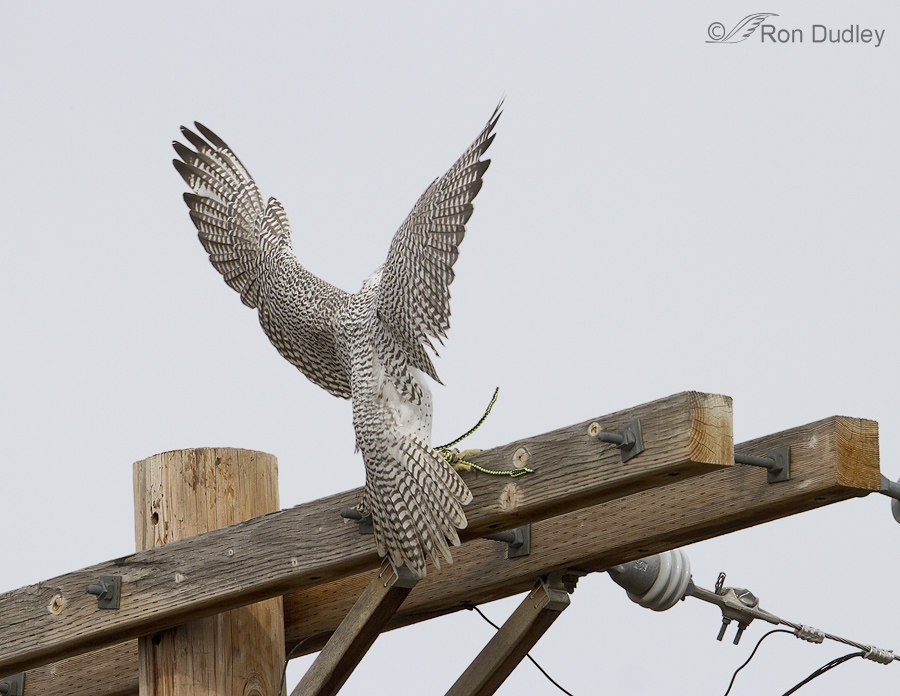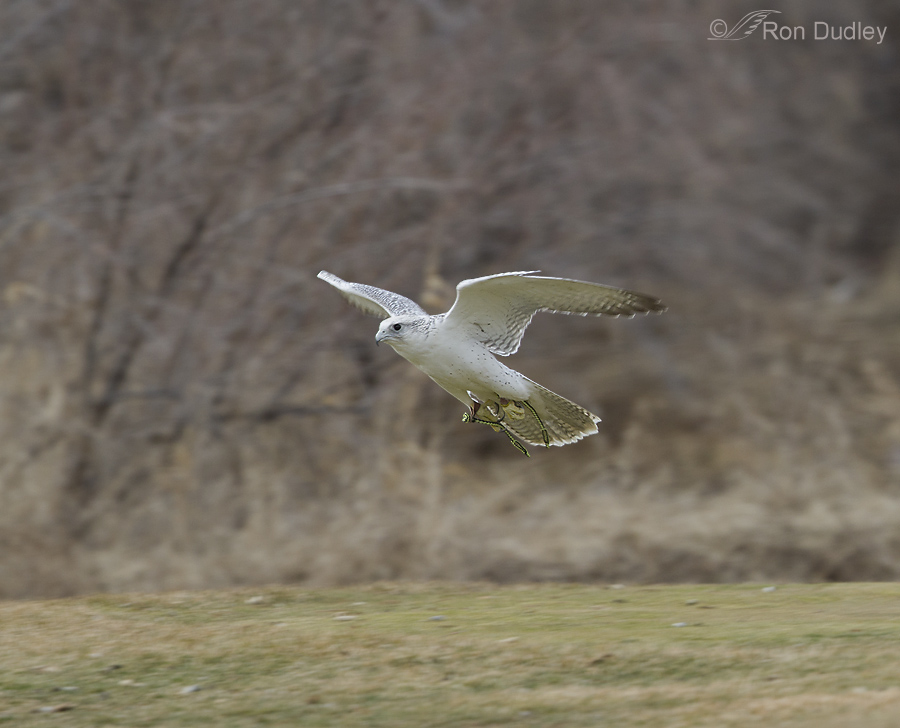This is my promised update on the eventual outcome of the recent escaped white Gyrfalcon saga.
1/3200, f/7.1, ISO 500, Canon 7D, 500 f/4 II, 1.4 tc
First a recap. On January 20, 2014 a sighting of a possible Snowy Owl was reported at Mick Riley Golf Course in Murray, Utah. Naturally it generated incredible interest in the local birding community but by the following morning it was confirmed to be a white Gyrfalcon with attached falconry gear. That afternoon I joined a phalanx of birders, photographers and bird lovers in watching, photographing and simply appreciating this stunning raptor.
1/2000, f/7.1, ISO 500, Canon 7D, 500 f/4 II
The Gyrfalcon was calm and approachable as it perched on a power pole adjacent to the golf course. Several times it flew off and circled the area but it usually returned to this pole. I include this “butt shot” to highlight the spectacular dorsal markings of the bird.
1/500, f/7.1, ISO 500, Canon 7D, 500 f/4 II
This bird obviously needed to be captured because of the danger of entanglement presented by the attached jesses – HawkWatch International to the rescue! Mike Shaw from HWI eventually captured the bird and took it to a safe and appropriate location until the birds owner/handler could be located and a decision made as to its eventual fate. The three year old female weighed 1427 grams and was healthy and well cared for. Her halluces had been filed down and her bill was ready to be coped but had not been neglected. Here the falcon is investigating a bal chatri trap just out of frame to the left.
Tracking down the owner of this bird wasn’t easy (understatement!) but eventually it was determined that the falcon had escaped from a local falconer by chewing through its leash a day or two before it was spotted at the golf course. Once it was confirmed that the falconer had legal possession of the bird and all of his permits were in order (the falcon had been purchased from a breeder in Idaho) the bird was returned to him. He was delighted to get his falcon back.
Once again HWI has provided a valuable service to our raptors and to the birding/falconry community. I’m definitely a fan and have been for some time. Their mission is to “conserve the environment through education, long-term monitoring and scientific research on raptors as indicators of ecosystem health”. As a retired teacher I especially support the “education” part. If you’re interested here’s a link to more information about their mission, history and goals.
I believe they deserve our support, financial and otherwise.
Ron





What an utterly gorgeous bird! This is one I don’t expect to see in person, so I’m delighted to see the photos. I especially like the butt shot – the pattern of the feathers is nothing short of amazing. Glad this story had a happy ending, and thanks to Louise Shimmel for the explanation of falconry.
As a former rehabber, I do like these happy endings!So often, the balance tips the other way.
And thank you to Louise for the falconry information.Here, in Australia, it is illegal to keep and hunt birds like this.There are some people who hold special permits for education purposes, but the sport is outlawed.
Interesting. I’d forgotten that the practice of falconry was prohibited in Australia (someone had pointed it out to me before but it slipped my mind until this reminder).
Great news, Ron … and they deserve a round of applause as well!!!
Yes they do, Lois. Thanks.
Wonderful news. And I love that butt shot too (which makes me wonder about myself a little).
Don’t “wonder about yourself” at all, Elephant’s Child. I can vouch for your good taste…:)
Ellen and others – This thread has elicited a lot of comments about falconry, and I’m feeling like some information might be useful. Falconry is a sport that’s thousands of years old; so old, no one is 100% sure in what part of the world it originated. The bird is definitely not a pet, although the falconer typically spends several hours a day with it. Essentially it is both the weapon with which game is caught and even more, a partner in the hunt. Many falconers also hunt with a dog, again in partnership with the bird. That is, the bird is taught to trust the dog, and when they all go into the field together (typically daily during hunting season), the dog searches for game and ‘points’ it – the falconer releases the bird, and once it is in a good position, the dog flushes the prey. Without a dog, the falconer flushes the prey for the bird. It might be ducks on a pond or a hare in the brush. Different types of birds are used for different prey. The falcon or hawk (even some eagles and a very few owls) is flying free and could leave at any time; but they quickly learn that their chances for hunting success improve with the partnership. They don’t ‘retrieve’ the prey, of course; but once the prey is down, the falconer runs over and sometimes (especially with larger prey, like ducks, rabbits or squirrels) helps dispatch the prey for a humane kill; the bird is allowed to take a few bites, and then it trades off its kill for some treat the falconer carries in his vest, while stepping back on the glove. The prey is then put into the vest for consumption later (by the falconer and/or the bird); and the whole thing is repeated. The bird is not successful every time, of course, but getting to watch the incredible flights and attempts, along with this very special relationship with the bird, is what draws people to falconry. Rarely is an observer (birder or casual passerby) able to see a raptor hunt and catch (or not) its natural prey.
There are falconers who read this blog and who can answer in more detail, of course – I am not a falconer. But as a raptor rehabilitator, I have an understanding of what’s involved in falconry and we work closely with several falconers in our area. They are very helpful in assessing a rehabilitated bird in terms of its releasability – whether its flight is perfect after a fracture, say, or dislocation; they also help us with young birds, providing them with the opportunity to catch live prey like birds that we cannot possibly replicate in a cage, no matter how large. And what falconers have learned over these thousands of years has made keeping raptors in captivity much easier, e.g., what they need in terms of diet, housing, training, equipment like jesses and swivels, flying them with transmitters, etc. More and more falconers
are using operant conditioning (positive reinforcement) as their training method. In the old days, most wild-trapped birds were eventually released, now competent hunters, kept through the highest mortality period of their lives (the first winter), now capable of entering the population as a bird with a good chance of survival and reproduction.
All that said – I’m sure my respect for most falconers is clear – it doesn’t mean that every falconer is conscientious; many have enormous egos and THEIR way is the only way (but, heck, I’ve met wildlife rehabilitators or veterinarians like that, too.) They have a typical contingent of idiots, like any field (but for me the prize is the falconer/breeder who was poisoning rodents in the same barn in which he kept his birds and then called me because one of them got a poisoned rat!) Many wildlife photographers are not as ethical as Ron in terms of not baiting in birds (I cringe every time I see a shot of a snowy owl or great gray owl catching a mouse on top of trackless snow … clearly a set-up) or trying so hard not to disturb them. So it’s best not to judge an entire field, or sport, by either the best of it or the worst of it – but to make decisions on an individual basis as to whether you think something is appropriate, after you’ve made every effort to understand what’s actually involved.
Ok – off soapbox! What I would recommend to anyone interested is to find a local falconer or falconry club and see if they are willing to take observers into the field. It is an unparalleled to see a natural activity – a magnificent bird hunting – that happens thousands of times a day but that we rarely have the chance to see.
I’m delighted that you took the time to give us this look at “falconry in a nutshell”, Louise – I found it enlightening on many levels and it reinforces some of my own views. Thank you!
A happy ending I hope. I love the photo of the bird from the back. Amazing. What does a falconer actually do with the falcons? I’d love to have a bird in my house but I actually think it’s cruel. They need to be outside and able to fly free…Just my opion. Glad this situation worked out.
Ellen, Falconers hunt with their birds. And they are very devoted to them. However the relationship between falconers and their birds is a complex one – books could be written to fully answer your question.
thanks Ron. I will look I to that more.
Ron, Thanks for the kind words and, as always, the stellar camera work. Your blog certainly generated an incredible interest in the bird itself and an enlightening discussion from a variety of viewpoints. Good stuff. We received a surprising number of inquiries from falconers across the country hoping this Gyr might be their long lost bird. Several who’ve been looking for years!! We began having grand visions of her flying in from hundreds or even thousands of miles away… Ah well, maybe not as romantic as we imagined, but definitely a lot easier to get her back where she belonged.
“Rescue” isn’t something that HawkWatch does regularly, but the chance to corral a loose white Gyr was the perfect excuse for our staff biologists to knock off early on a Friday afternoon. Ha! And though that big white beast threatened to eat us out of house and home, our Education and Bird Care staff loved spending a few days with her.
Again, thank you. And thanks also to the Wyoming and Utah state wildlife agencies and the Utah Falconers Association for their diligent efforts in locating this beautiful bird’s owner.
I can only imagine how much your staff enjoyed being around this falcon, Mike. I was enthralled being its presence just at the golf course!
Kudos to the entire HWI staff for a job well done – you in particular.
Incredible butt shot! Excellent work HWI.
Thanks, Sharon.
A happy ending for a change…what a relief! Love the “butt shot”…incredible detail from an angle rarely seen. All your shots of this breathtakingly beautiful bird have been wonderful and exciting to see…can barely imagine how exciting it must have been to actually see it “in person”….
That’s a butt shot that I like too, Patty – and you know how I usually feel about that type of shot…
Great news! Love the “butt” shot so I could see the beautiful markings – thank you 🙂
More wonderful shots Ron! Glad to hear it, I guess it ended well.
Charlotte
Yes, Charlotte – I think it did end well. Thanks.
Well done, Ron. You should be proud of the result of your efforts to protect this bird and get her home where she belongs.
Thanks, Mark – but actually the only thing I deserve any credit for is documenting the situation. HWI and Mike Shaw did all the legwork.
Congratulations Ron, Excellent, job well done!!
Thank you, Dick.